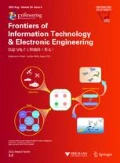Abstract
There has been a framework sketched for learning deep bidirectional intelligence. The framework has an inbound that features two actions: one is the acquiring action, which gets inputs in appropriate patterns, and the other is A-S cognition, derived from the abbreviated form of words abstraction and self-organization, which abstracts input patterns into concepts that are labeled and understood by self-organizing parts involved in the concept into structural hierarchies. The top inner domain accommodates relations and a priori knowledge with the help of the A-I thinking action that is responsible for the accumulation-amalgamation and induction-inspiration. The framework also has an outbound that comes with two actions. One is called I-S reasoning, which makes inference and synthesis (I-S) and is responsible for performing various tasks including image thinking and problem solving, and the other is called the interacting action, which controls, communicates with, and inspects the environment. Based on this framework, we further discuss the possibilities of design intelligence through synthesis reasoning.
Similar content being viewed by others
References
Ballard DH, 1987. Modular learning in neural networks. Proc 6th National Conf on Artificial Intelligence, p.279–284.
Dayan P, Hinton GE, Neal RM, et al., 1995. The Helmholtz machine. Neur Comput, 7(5):889–904.
Hinton GE, Salakhutdinov RR, 2006. Reducing the dimensionality of data with neural networks. Science, 313(5786):504–507. https://doi.org/10.1126/science.1127647
Hubel DH, Wiesel TN, 1962. Receptive fields, binocular interaction and functional architecture in the cat’s visual cortex. J Physiol, 160(1):106–154.
Le QV, Ranzato M, Monga R, et al., 2011. Building highlevel features using large scale unsupervised learning. https://arxiv.org/abs/1112.6209
Pan Y, 1996. The synthesis reasonning. Patt Recogn Artif Intell, 9:201–208.
Qian X, 1983. On thinking sciences. Chin J Nat, 8:566.
Xu L, 1991. Least MSE reconstruction for self-organization: (II) further theoretical and experimental studies on onelayer nets. Proc IEEE Int Joint Conf on Neural Networks, p.2362–2367.
Xu L, 1993. Least mean square error reconstruction principle for self-organizing neural-nets. Neur Netw, 6(5):627–648.
Xu L, 1995. YING-YANG machines: a Bayesian-Kullback scheme for unified learning and new results on vector quantization. Proc Int Conf on Neural Information Processing, p.977–988.
Xu L, 2010. Bayesian Ying-Yang system, best harmony learning, and five action circling. Front Electr Electron Eng China, 5(3):281–328.
Xu L, 2019a. Deep IA-BI and five actions in circling. Int Conf on Intelligent Science and Big Data Engineering, p.1–21.
Xu L, 2019b. An overview and perspectives on bidirectional intelligence: Lmser duality, double IA harmony, and causal computation. IEEE/CAA J Autom Sin, 6(4):865–893. https://doi.org/10.1109/JAS.2019.1911603
Author information
Authors and Affiliations
Corresponding author
Additional information
Compliance with ethics guidelines
Lei XU declares that he has no conflict of interest.
Project supported by the National New Generation Artificial Intelligence Project, China (No. 2018AAA0100700) and the Zhiyuan Chair Professorship Start-up Grant from Shanghai Jiao Tong University, China (No. WF220103010)
Rights and permissions
About this article
Cite this article
Xu, L. Learning deep IA bidirectional intelligence. Front Inform Technol Electron Eng 21, 558–562 (2020). https://doi.org/10.1631/FITEE.1900541
Received:
Accepted:
Published:
Issue Date:
DOI: https://doi.org/10.1631/FITEE.1900541
Keywords
- Abstraction
- Least mean square error reconstruction (Lmser)
- Cognition
- Image thinking
- Abstract thinking
- Synthesis reasoning




